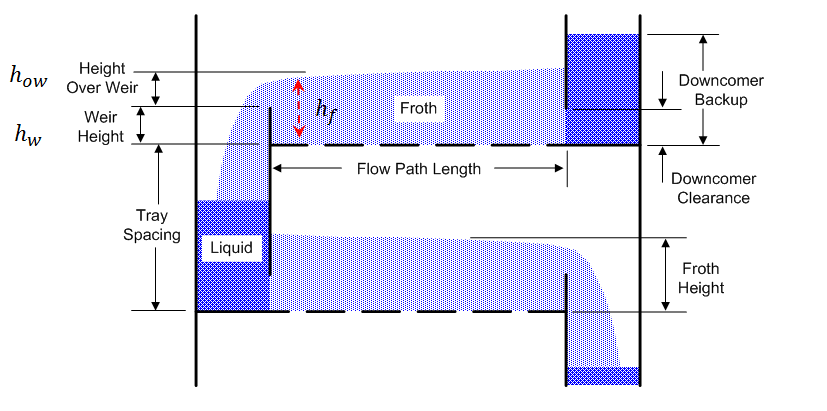Columns
The detailed column solutions provided by ProMax for both ideal-stage and mass and heat transfer columns can provide you with the relevant information
for sizing and rating your column designs. ProMax is capable of predicting parameters for many types of columns, including Liquid-Liquid (LLE),
Vapor-Liquid (VLE), and Vapor-Liquid-Liquid (VLLE) separations, utilizing trayed or packing type hardware. ProMax also supports multi-section towers,
including towers that consist of trayed and packed sections, towers with multiple diameters, and towers partially filled with catalysts.
Column Performance
Detailed stage data is presented on both a phase and component basis for each stage within a tower, including an extensive list of physical
properties and flow rates. The ProMax Column dialog automatically reports all component recoveries for each product stream, allowing easy monitoring
of the column performance. Plots and tables can be generated depicting the column temperature profile, phase flow rates, component flow rates, and many
other properties.
Pressure Drop
ProMax can estimate the pressure drop through trays and packing using several methods, including Sulzer and Billet-Schultes methodologies. For trayed
towers, the pressure drop calculation includes both the dry pressure drop, and the pressure drop through the aerated mass. Depending on the tray type,
this calculation takes into account the fraction hole area, hold diameter, tray thickness, multiple pressure drop regions, material of construction,
valve thickness, valve lift, tray thickness, and other relevant information. For packed towers, the pressure drop includes, among other values, the
liquid hold-up and dry-packing resistance coefficient.
Beginning in ProMax 4.0, the calculated Pressure Drop can be used as the specified pressure drop in the column by selecting the “Pressures from Hardware”
option. Combining this option with detailed column internal information allows ProMax to model your facility design as accurately as possible, especially
through scenarios where the column loading may be changing significantly.
For ideal stage models, a single “real to ideal stage ratio” allows ProMax to extend information from the theoretical stages into a real column pressure
drop calculation. For mass and heat transfer columns, the simulation is based on the actual number of trays of the tower, making these columns as simple
as possible to envision.
Column Flooding
Predicting a column’s performance and efficiency is highly impacted by the predicted flooding within the tower. ProMax can calculate several types of
column flooding for you to investigate or control, including:
- Fair’s Fraction Flooding
- Glitsch Flooding,
- System Limit Flood,
- Packing Factor Model,
- Sulzer Flood Model,
- Billet-Schultes Model
Some flooding values can be set directly, allowing for simple column sizing estimations at various process conditions. For existing columns, the
flooding will be calculated on each stage or tray. In the case of Liquid-Liquid towers, the liquid loading may be specified to help size a column
within appropriate guidelines.
For accurate flooding prediction, the Liquid Frothing must be estimated accurately. ProMax includes the Bolles-Fair, Stichlmair, and Colwell
methods to help you investigate the frothing potential of your system.
Trayed Tower Design
ProMax includes many parameters for detailed sizing and analysis of your sieve or round valve trayed columns. For quick results, ProMax has
common default values for most parameters, helping to minimize the amount of time required to get a quick tower sizing or rating result. For
both ideal stage and mass and heat transfer columns, the tray information is input based on real tray information.
If desired, a much more detailed investigation can be performed in ProMax by defining as much tray information as you have available:
- Number of passes (single-pass, two-pass, three-pass, and four-pass tray configurations are supported)
- Weir height and weir side width
- Tray active area, tray spacing, hole area, tray thickness
- Downcomer clearance,
- Valve lift, valve thickness
- Material of construction
Once you have defined as much information as you know, ProMax will calculate many additional parameters and values for your review.

Packed Tower Design
In addition to the capabilities ProMax has for trayed towers, ProMax can size and rate columns with random or structured packing. The ProMax
database includes an extensive collection of information for hundreds of packing types. In addition to the temperatures, pressures, vapor and
liquid flow rates on each section of the tower, ProMax will also calculate the linear holdup time, stage pressure drop, and more. For ideal
stage modeling, the user may simply estimate the number of ideal stages contained within the column based on an HETP value. For mass and heat
transfer modeling, the height of packing should be defined, along with the number of transfer units (“stages”) for the tower.
ProMax includes detailed information on over 140 random packing types, including:
- Berl saddles™
- Cascade Mini-Rings™
- FLEXIRING™
- Hiflow Ring™
- HY-PAK™
- IMTP™
- Intalox Saddles™
- Nor-Pac Rings™
- Pall rings
- Ralu-Flow™
- Ralu-Rings™
- Raschig Rings™
- Raschig Super-Rings™
- Snowflake™
- Sulzer Nutter Rings™
- Super Intalox Saddles™
- Tellerettes™
Additionally, ProMax includes detailed information on over 65 structured packing types, including:
- FLEXIPAC™
- INTALOX™
- Sulzer Mellapak™
- Sulzer Mellapak Plus™
- Sulzer Mellagrid™
- Sulzer Mellacarbon™
- Sulzer Gauzes™
If ProMax does not include a specific packing type you are interested in investigating, user-defined
packing types may be created, utilizing the Billet-Schultz methods – simply provide some information on the specifications of the new packing in our
Column Hardware XML file.
Optimization Options
Expand knowledge of your facility capabilities by investigating parameter changes with the
ProMax Scenario Tool®. Some possible studies might include reviewing the effects of:
- Varying gas or liquid rates through the column
- Different packing bed heights
- Changing residence times on reactive columns
- Column flooding due to tray design
- Varying HETP values